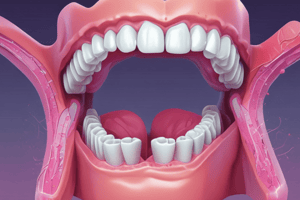Podcast
Questions and Answers
What are the clinical features of giant cell fibroma?
What are the clinical features of giant cell fibroma?
- Painful nodules
- Yellow to yellow-white neoplasms of fat
- Slow-growing masses
- Asymptomatic, nodules less than one centimeter in size (correct)
What is the hallmark of giant cell fibroma?
What is the hallmark of giant cell fibroma?
Presence of large, stellate fibroblasts with several nuclei
Fibromatosis and myofibromatosis are aggressive proliferations of myofibroblasts.
Fibromatosis and myofibromatosis are aggressive proliferations of myofibroblasts.
False (B)
Lipomas are benign neoplasms of _ cells.
Lipomas are benign neoplasms of _ cells.
Match the following: Fibrous Histiocytoma with its location
Match the following: Fibrous Histiocytoma with its location
Where are neurofibromas most frequently found?
Where are neurofibromas most frequently found?
Neurofibromas are usually painful nodules.
Neurofibromas are usually painful nodules.
What are the histological components of neurofibromas?
What are the histological components of neurofibromas?
The treatment for solitary neurofibromas is ____________.
The treatment for solitary neurofibromas is ____________.
Match the following clinical features with the respective conditions:
- Café au lait spots
- Lisch nodules
- Optic gliomas
- Bony lesions
Match the following clinical features with the respective conditions:
- Café au lait spots
- Lisch nodules
- Optic gliomas
- Bony lesions
Flashcards are hidden until you start studying
Study Notes
Giant Cell Fibroma
- Presents as asymptomatic, sessile or pedunculated nodules less than 1 cm in size
- Sixty percent are diagnosed during the first three decades with a slight female gender predilection
- Fifty percent occur on the gingiva, with the mandible being more commonly affected than the maxilla (2:1)
- Histological features: vascular, loosely arranged fibrous connective tissue with large, stellate fibroblasts and multiple nuclei
- Treatment: conservative surgical excision; rarely recurs
Fibromatosis and Myofibromatosis
- Fibromatosis: a broad group of fibrous proliferations with a biological behavior ranging from benign to malignant
- Presents as a firm, painless mass that may grow rapidly or slowly
- More common in children and young adults with a mean age between 8 and 11 years
- Predilection site: paramandibular soft tissues
- Can grow to a large size and destroy bone
- Myofibromatosis: a similar but less aggressive proliferation of myofibroblasts
- Presents as a firm mass in the dermis or subcutaneous tissues of the head and neck
- Cases of intraosseous myofibromatosis have been reported
- Histopathology: unencapsulated, solid, nodular mass of dense, hyalinized connective tissue
- Treatment: wide surgical excision for fibromatosis, with a 23% recurrence rate; local excision for myofibromatosis, with possible spontaneous regression
Fibrous Histiocytoma
- A diverse group of tumors that exhibit both fibroblastic and histiocytic differentiation
- Can occur anywhere in the body, but most common in the skin (dermatofibroma)
- Uncommon in the oral/perioral region, with the buccal mucosa being the most common intraoral site
- Presents as a painless nodular mass
- Treatment: local surgical excision, with rare recurrence
Lipoma
- Benign neoplasm of fat cells
- Most common soft tissue tumor in the body, but not so common in the mouth
- Prevalence: 3/10,000
- Presents as an asymptomatic, slow-growing, well-circumscribed, yellow to yellow-white benign neoplasm of fat
- Treatment: excision, with a limited growth potential and no recurrence expected
Leiomyoma
- Benign tumor of smooth muscles
- Rare in the oral cavity
- Originate from vascular smooth muscles
- Three types: solid, vascular, and epithelioid
- Presents as a slow-growing, firm, mucosal nodule
- Treatment: local surgical excision, with no recurrence
Rhabdomyoma
- Benign tumor of skeletal muscles
- Rare tumors
- Predilection for the head and neck
- Subclassified into adult and fetal rhabdomyomas
- Presents as a nodule or mass that can grow to several centimeters
- Treatment: local surgical excision, with no recurrence
Traumatic Neuroma
- Reactive proliferation of neural tissue following transection or damage to the nerve bundle
- Presents as a smooth, non-ulcerated nodule
- Predilection sites: mental foramen, tongue, and lip
- May produce a radiolucent defect if bone is involved
- Treatment: surgical excision, with the excision including a small portion of the involved nerve bundle
Palisaded Encapsulated Neuroma
- Benign neural neoplasm
- Presents as a solitary, smooth, painless, dome-shaped papule or nodule
- Common sites: face, palate, and lip
- Histological features: well-circumscribed, encapsulated tumor consisting of interlacing fascicles of spindle cells
- Treatment: conservative local excision, with rare recurrence
Neurilemoma (Schwannoma)
- Benign neural neoplasm of Schwann cell origin
- Relatively uncommon lesion, but 25-48% of all cases occur in the head and neck region
- Presents as a slow-growing, encapsulated tumor associated with the nerve trunk
- May cause pain, expansion, radiolucency, or paresthesia
- Treatment: surgical excision, with rare recurrence and extremely rare malignant transformation
Studying That Suits You
Use AI to generate personalized quizzes and flashcards to suit your learning preferences.




